Pillar subscribers can hear Ed read this Pillar Post here: The Pillar TL;DR
Happy Friday friends,
There is a fairly full slate of news to get through this morning, so I’ve got to cut down on the preamble, I’m afraid.
In addition to all the things we’re going to go over in a minute, we’re busy tracking a few stories that haven’t broken water (yet) and we are working hard to keep tabs on. More on all of that as soon as we can.
And for all those of you who are free readers, just a reminder that all this journalism we are doing is a service we offer, and an apostolate we try to live. But it’s also a serious day job for all of us here.
So, if you're reading this newsletter and happen to think the laborers deserve their wages, we’d appreciate it.
Here’s the news.
The News
The top story this week is the Dicastery for the Doctrine of the Faith’s decision to prosecute the former nuncio Archbishop Carlo Maria Viganò for schism.
The archbishop faces an extrajudicial process — a canonical mechanism reserved for cases in which a preliminary investigation produces sufficiently compelling evidence that a full trial process is deemed unnecessary.
In other words, the DDF has signified that it pretty well expects to convict him.
Posting his own citation to appear, Viganò seemed to give an indication of how that conclusion was drawn, calling the charge of schism a “badge of honor” and stating that Vatican Council II “represents the ideological, theological, moral and liturgical cancer of which the Bergoglian ‘synodal church’ is [a] necessary metastasis.”
I’ll give my own thoughts on the case in a minute.
But first, get up to speed with what’s happening and what it all means right here.
—
Sticking with schism, nuns at a Spanish convent accused of breaking communion with the Church have been given a June 21 deadline to appear before a Church tribunal, as they face the prospect of excommunication.
Three of the nuns, from the Poor Clare convent of Belorado, were originally expected to appear before the tribunal by June 16, but received an extension, sources close to the case explained to The Pillar.
The nuns announced a separation from the Catholic Church last month, by claiming to fall under the jurisdiction of an excommunicated, sedevacantist, self-proclaimed bishop, rather than the governance of their actual territorial bishop.
Ten of the 16 nuns of the convent are in the midst of excommunication proceedings. The Archdiocese of Burgos decided not to include five of the older nuns in the proceedings.
Another, Sr. María Amparo, asked to leave the community when she learned of the community’s plans to leave the Church.
Stay up to date with the story here.
—
Moving away from formal, as opposed to merely material, schism…
The Church in Germany’s “synodal committee” took a significant step toward the creation of a permanent nationwide synodal body during a two-day meeting in Mainz last week.
The synodal committee was established at the end of the country’s controversial “synodal way” in 2023, to lay the groundwork for a permanent “synodal council” of bishops and lay people by March 2026.
A June 15 press release announced that the synodal committee has established three 10-member commissions, the first of which will address “the possible organization of a synodal council.”
Thomas Söding, the vice-president of the influential lay Central Committee of German Catholics (ZdK), said: “The point is that… the authority of the bishops and the bishops’ conference will be interlinked in a good way with the rights of participation from the people of the Church, which have been neglected to date.”
I’m sure that will all absolutely be in line with canon law.
—
Switching gears slightly, and looking ahead to next month’s Eucharistic Congress in Indianapolis, JD has a very interesting analysis that is worth your time:
In and amongst the schedule of daily Masses at the congress, two of them will be offered according to the 1962 Roman Missal — “Traditional Latin Masses” — one by Archbishop Salvatore Cordileone and the other offered by an Indianapolis priest, the pastor of the personal parish where the Masses will be held.
As JD says, the fact that the Masses are being scheduled at all is likely to come as a surprise to many — with some TLM adherents likely expecting to have been frozen out of the schedule altogether and others presuming any such event would run afoul of at least the “spirit” of Pope Francis’ motu proprio Traditionis custodes.
Sources close to the Congress have told The Pillar that organizers wanted to see the Extraordinary Form of the Mass offered out of genuine pastoral concern for Catholics strongly attached to the old form of the liturgy.
But, as JD points out, their efforts are likely to be met with resentment and criticism from a few folks on all sides.
The venue chosen is a church that seats 400, probably well below the likely potential draw among congressional attendees, which could fuel complaints of their being “marginalized” and drive up numbers at a rival event being staged across town, sponsored by “Lifesite News,” featuring priests suspended from ministry by their bishops.
Others will probably insist that having any TLM liturgies on the official agenda is proof of an “anti-Francis” plot at the congress.
It’s an unenviable position the congress is in, and there’s probably no good answer. Read the whole analysis here.
Speaking of events in Indianapolis, just a reminder that JD and I will be there hosting a live show on July 18, after the day’s official programming is over. So please come!
Tomorrow, Vatican doctrinal chief Cardinal Víctor Manuel Fernández will serve as principal consecrator at the episcopal ordination of the new leader of the U.K.’s personal ordinariate.
Following the ceremony at Westminster Cathedral in London, Fr. David Waller will be the first bishop to lead the body established in 2011 for groups of former Anglicans in England and Wales entering full communion with Rome.
What exactly is a personal ordinariate? Why is the Vatican’s doctrinal czar serving as principal consecrator? And what difference will having a bishop make to the Ordinariate of Our Lady of Walsingham?
Well, Luke Coppen takes a look in this typically excellent explainer.
—
The Institute for Works of Religion (IOR), which I have now just given up trying to get people to stop calling “the Vatican Bank,” has issued its annual report and, perhaps to the surprise of many, it’s doing quite well, actually.
Profits are up, and so are charitable disbursements. It’s grown its assets under management. And its TIER 1 capital ratio and intermediation margin are industry-leading strong.
Now that the bank’s on a sure footing, it’s been charged by Pope Francis with becoming the curia’s sole deposit bank and asset manager. Making that papal directive actually happen is going to be a Herculean task — many Vatican departments are going to slow roll and outright ignore the order for as long as they possibly can. And then begins the real job of actually getting the Vatican’s money to work for a change.
Key to all of this, I argue, is keeping the IOR’s leadership team of president and director general intact. Both men have survived bruising encounters with the strongest opponents of financial reform Rome has to serve up and lived to fight another day.
But the thing is, last year Francis gave the bank new statutes which, while broadening its operational independence, also imposed term limits on its senior managers.
The president, Jean-Baptiste de Franssu, is now in the final year of his second, and now supposedly non-renewable, five-year term.
I say “supposedly” because Francis has shown a fairly notional interest in holding people to mandatory retirement ages and term limits if he thinks they’re doing a job for him. So there’s every reason to expect him to ask de Franssu to stay on past his 10-year anniversary at the bank.
But if he doesn’t, I’d say all the progress made at the bank would be up for grabs.
—
The Church in Slovakia may not be on your radar, but the small Central European nation boasts a deep Catholic tradition, maintained even through decades of communism in the 20th century.
It also has, in Bishop Jozef Hal’Ko, a seriously interesting and innovative contributor to modern evangelization. The bishop has something of a high public profile in Slovakia via his online presence and Na minútku (One minute) homily series.
This is a very interesting conversation.
Upstream, a new podcast from Patrick Lencioni, provides ideas and encouragement so courageous priests can more effectively run their parishes and spread the Gospel. Pat is not only a passionate Catholic but is the pioneer of the organizational health movement and one of the world’s foremost experts on leadership and teamwork.
The (relative) madness of Archbishop Viganò
The news that Archbishop Carlo Maria Viganò is now facing formal charges of schism is, for many people, long overdue.
Since 2018, he’s been on a steep downward trajectory, putting him ever more publicly and sharply at odds with Pope Francis, whom he has denounced in personal and often what I would consider to be canonically unambiguous terms.
He has also moved from aggrieved whistleblower in the McCarrick scandal to in-terms rejector of Vatican Council II, passing through a gamut of political and other conspiracy theories along the way.
Breathless calls for the pope to do something about Vigano, and laundry lists for why he should, are pretty much ten-a-penny. I would, though, say that the slowness of Rome to pursue formal charges against him was notable, if not entirely inexplicable. When a bishop goes rogue, and makes a personal brand out of breaking with the pope, there’s a prudential judgment to be made about when and how to take canonical action.
Even if you laicize such a person, he remains a consecrated bishop, capable of validly (albeit illicitly) imparting the sacrament of sacred orders — driving up the celebrity of schismatics and granting them formal martyr status among their devotees can result in the flowering of mini schismatic Churches if you’re not careful.
Given that the archbishop chose to post his decree of citation on the internet and call Pope Francis and Vatican Council II “cancer” on the day he was supposed to appear at the DDF to review the case against him, I’m assuming he does not plan on mounting a serious canonical case in his own defense — which I’d have thought he would relish, if he had a serious case to make.
Instead, he appears to be reveling in the anticipation of some kind of ecclesiastical censure.
That being the case, the DDF will ex officio appoint some lucky canonist to act as his advocate, with or without the former nuncio’s input.
Having previously served as a defense advocate before the DDF, I’ve been wondering what strategy I would deploy if I were tasked with fighting his canonical cause. In all honesty, I think I would be pleading diminished capacity here.
I’m not saying that Archbishop Viganò is insane, or lacks responsibility for his words and actions, but canon law does direct that due and proper penalties be “tempered” if the crime was committed “by a person who had only the imperfect use of reason,” as opposed to lacking it altogether.
Without having access to the DDF’s investigation files, and just commenting on what I know looking in from the outside, I think there’s a real case to be made here that Viganò’s been operating with an imperfect use of reason for a while — and I’d be perfectly comfortable arguing that in good faith at the DDF.
For a start, I think it is reasonable to question the due discretion of judgment of anyone who looks at the Russian invasion of Ukraine, the mountainous evidence of war crimes, and the established wholesale kidnapping of children there, and decides to publicly back Vladimir Putin as the champion of Christian civilization.
In fact, I would say that Christian charity demands we assume such a person is operating without their full critical faculties, since the alternative would seem to be they are a moral monster or the worst kind of cynical shill.
Working backward from there, the archbishop’s personal endorsement of “New World Order” conspiracy theories on everything from COVID vaccines to election results in 2020 should, I think, give anyone pause about his rational capacity.
Of course, it’s perfectly possible that Viganò has adopted all these positions with the full use of reason, perhaps as a ploy to attract followers, and even funds, in his self-imposed exile, but that doesn’t necessarily tally with the full picture of the man.
Those who knew him well during his time as nuncio in Washington tend to recall an almost painfully earnest man, and one often out of his depth and laboring visibly under considerable emotional stress — many recall his tendency to tear up in private conversations.
And the circumstances of his arrival in Washington in the first place would have been enough to test the emotional limits of many. His previous position, as secretary general for the governance of the Vatican City State, put him front and center in the fight against rampant curial corruption during the reign of Benedict XVI.
It was a battle he waged with little support but considerable initial success — he turned a nearly 10 million euro operating deficit into a nearly 40 million euro budget surplus in a single year. But it also made him a lot of enemies.
Following the Vatileaks scandal and the public loss of confidence of his own colleagues (at least some of whom, I’d hazard to say, had reason to want his reforming efforts stopped), Benedict opted to post Viganò overseas.
The polite line taken by “respectable,” not to say “kept,” Vatican journalists was that he wasn’t a reforming whistleblower so much as a problem personalty in the office, a bit of an alarmist about likely non-existent systematic corruption, and that he needed to be moved on.
Without in any way signing up to his later positions, I would say history vindicated Viganò on that one.
Anyway, he arrived in D.C. with a notable sense of betrayal by both his former curial colleagues and the pope personally, compounded by an intensely bitter public family dispute with his brother, which wound up in an Italian court and about which he would often confide emotionally to people he’d only just met.
Washington was not a post for which he was well-suited, by temperament or experience, and his involvement in internal Church affairs in this country was often confused, confusing, and well worthy of criticism.
He was hardly any more adroit at the diplomatic side of things, memorably inviting the non-Catholic Kentucky court clerk at the center of the country’s political storm over same-sex marriage to meet Pope Francis, doing so against the strong advice of both the USCCB president and Archbishop of Washington.
He left office shortly thereafter, having reached the retirement age of 75, before bursting back into public life during the McCarrick scandal of 2018, in which he mixed often compelling accounts of what he and his predecessors at the D.C. nunciature knew about the former cardinal with near-hysterical demands that Pope Francis resign.
As a canonist, I’d have no qualms looking at this timeline and suggesting that Viganò was an emotionally fragile, isolated, and increasingly bitter man who arrived at a mental and emotional breaking point — exactly the sort of circumstances that can leave people open to fringe movements and conspiracy theories, be they about Vatican Council II (a subject about which he’d never previously voiced any strong opinion), COVID, or secret one-world governments.
I am not saying — and as a lawyer I could not in good conscience argue — that Viganò doesn’t bear responsibility for his words and actions and couldn’t (or shouldn’t) face canonical penalties, both for his own good and to repair the scandal he continues to cause.
And, frankly, were I the promoter of justice here, I would consider the case for schism to be open and shut. I expect Viganò to be convicted, probably laicized, and I would consider the penalty well-merited on his most recent statement alone. As a canonical friend observed to me yesterday after reading Viganò’s latest salvo against the pope, there’s not much left to do here but the dishes.
But, thinking as his canonist, and seeking to find the strongest argument for leniency I could, I think there’s a reasonable case to be made that we are dealing with a deeply damaged man, one who has been acting out of pain as much as anything else for a long while.
It’s not an excuse, but it seems like a context worth considering.
In defense of ‘cruelty’
I tapped out of my former career in British politics some years ago. After nearly a decade fighting general elections, parliamentary by-elections, London mayoral campaigns, and the odd national referendum, I quit the game more than a decade ago with hardly a look back over my shoulder.
Pretty much anyone I worked with, liked, or admired from those days has long since checked out, too. Those who’ve come along since have done their damndest to cure me of any residual sense of tribal loyalty.
So I have been watching the current U.K. election unfold with a distant sense of morbid fascination, like seeing your old school burn down.
But if anything was going to stir me to get back in the game, it was learning that the almost-certainly-incoming Labour government plans to impose a national ban on the sale of foie gras.
I love foie gras.
I’ve loved it since the first time I tried it, as a 13-year-old road-tripping through rural France with my family. We’d stopped in some small village, at a country restaurant so “typical” it was practically an anachronism.
The maison was family-run, with white table cloths and the teenage son waiting tables in black vest and bow tie. And in hove the six of us Americans with our imported Chevy suburban and barely a word of French between us.
To call the menu “traditional” would be a radical understatement, though it was a real struggle to pick out enough recognizable words to know what we were ordering.
I had no idea what terrine de foie gras was. Frankly, I had no idea what “terrine” meant. But it sounded fancy and, like any mildly self-aware American teenager on the continent, I did not wish to be thought unsophisticated, so I ordered it.
To my immature palate, the taste and texture of the thing was unlike anything I’d had before, like a cold purée of hot dogs. It didn’t exactly light my world on fire, but the look of naked incredulity on my parents’ faces as I ate it contentedly remains frozen in my memory. That I loved.
Three years later, we were out for a “fancy” family dinner as a Christmas treat and I saw foie gras on the menu and ordered it again, for the simple, silly reason of hoping to confound my parents again. I don’t remember their reaction that time, but I do remember the warm globe of goose liver served up on brioche, pendulously quivering after a quick sautée in sweet wine and barely holding itself together with the consistency of room temperature butter.
That was the serving I really fell in love with. I’ve ordered it every chance I’ve had since, anywhere I could.
The silly argument against foie gras — and Lord knows there are people who make it — is that it's just a stuck-up rich person’s food, the sort of thing upper-class types fork down in between servings of black truffle and roasted swan. So it must be bad because those sort of people eat it, and banning it is good because sticking it to them is good.
Now, leaving aside the fact that black truffle is widely over-rated, and that those most loudly in favor of banning foie gras tend to be quite well-to-do themselves, I concede that some people do stupid, performatively “look how opulent we are” nonsense with their food.
Any place that decorates its steaks with gold leaf, for example, commits a crime against cows and is a trap for wealthy rubes and Instagram kids. You wouldn’t catch me dead eating there.
But there’s nothing inherently “rich” about foie gras except the taste, and that is for everyone.
When Chicago tried to ban it, it was a local hot dog joint that turned the tide — thumbing its nose at the city ordinance, slathering it on red hots, racking up fines and turning the people on to the glory of the stuff and against the posturing of actually rich snobs like celebrity chef Charlie Trotter and the offensive, preachy, nannying of the single city alderman responsible for the ban.
The spurious argument against foie gras is that it’s mean to the geese.
Yes, the geese are force-fed for a few weeks before slaughter to fatten their livers up. But let’s be clear, geese have no gag reflex and their necks are built to swallow whole fish, live. A thin tube isn’t making much odds here for them. Study after study has shown that evidence of any real suffering for the birds as a result is, at most, inconclusive and the risk of actual injury small.
Far more determinative is the general standard of care taken of the livestock by the producer, and here your mileage will vary, as with any meat production. And to be clear: I’m not in favor of deliberate neglect or casual mistreatment. Battery farm conditions are a sin against our role as stewards of the created order, I don’t care what animal you’re raising or for whom.
And, just as importantly: Happy animals, as a rule, taste better.
OK, is gavage something the geese would choose for themselves, even in the best of welfare circumstances? Probably not, I grant you. But, all other welfare considerations being met, I’m OK with them getting a double serving for a few weeks, whether they want it or not.
If that’s cruelty, well I think it’s worth the price. We’ve been enjoying the objective deliciousness of fattened goose liver since the days of the Roman empire. It’s an important part of our cultural heritage.
The idea that specially fattening birds for the slaughter is somehow impossibly objectionable no matter what, given they are literally bred for the sole purpose of making the best possible meal for us, strikes me as downright misanthropic.
And, as with so many things that just bring a little pleasure into our lives, it tends to be opposed by the sort of people for whom sincere human enjoyment is an alien concept — the kind who get their jollies blocking traffic in rush hour, think spray painting Stonehenge is righteous, and argue that having kids is a crime against Mother Earth.
You know the sort, the ones who aren’t so much pro-animal and environment as against people — especially people enjoying themselves. Those people and their creeping killjoy worldview need to be resisted everywhere: at the ballot box, in our restaurants, in the streets.
Me being me, and wanting to have the meal of my life, I insisted on foie gras being served for dinner at our wedding reception.
When one of the guests, something of a tie-dyed type (on my wife’s side, of course) sniffily asked what the alternative was, I took a polite but firm line: “Not eating.”
I wasn’t rude or mean. I didn’t shame him for his ignorance or borrowed prejudices. Instead, I looked on it as a teaching moment. I approached it with an air of, dare I say it, synodality.
I asked him, as a courtesy to us, his hosts, and out of respect for the animal, who had given its life and liver for the feast, to at least give it a try. Wouldn’t you know it, but he polished it off and — to her visible confusion — housed down his wife’s portion, too. Then he thanked me.
That’s what I mean when I say the relative “cruelty” of foie gras is worth it, if you can call it cruelty at all — it went to create a shared experience so sincerely pleasurable for all concerned that it’s a standout moment for me at my own wedding, more than a decade and a half later.
That’s how you know a pleasure is authentically human: it fosters communion. That’s the magic of foie gras. That, and it tastes so good.
See you next week,
Ed. Condon
Editor
The Pillar








